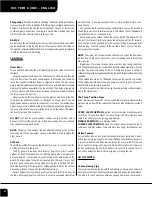
12
STEERING WHEEL PRESSURE
This pressure, or pull, is corrected by adjusng the trim
posion of your outboard so the prop sha is parallel to the
surface of the water. If this is not possible, the trim tab
located under the a end of the an-venlaon plate can
be adjusted by your dealer.
The trailing edge of the trim tab should be turned in the
direcon the boat is pulling. Small adjustments should be
made unl the steering has neutral torque (pull) at the
desired speed.
We suggest using your normal cruising speed. When
running faster or slower that this speed, a minimal amount
of torque will be present.
ELECTRICAL SYSTEM
Ba'ery (if fi'ed)
The key to a good marine electrical system is the ba'ery.
On some models the condion of the ba'ery can be read
on the voltmeter when the ignion switch is in the ON
posion.
With the engine not running, voltmeter readings in the 11.5
to 12.5 volt range are considered normal. Readings in the
10 to 11.5 volt range indicate a marginal charge condion.
Readings below 10 volts indicate a seriously discharged
condion.
With the engine running (over 1500 RPM), voltmeter
readings of 13 to 14 Volts are considered normal. Readings
below this indicate a severely discharged ba'ery or a non-
funconing charging system.
Check the ba'ery electrolyte level regularly. Remove the
caps on top of the ba'ery and observe the level of the fluid
inside, If the zinc plates are exposed, add dislled water
unl they are covered again. Corroded terminals can impair
ba'ery performance and charging ability.
Clean terminals with baking soda and water, then coat with
a preservave or a light film of grease. Be sure all ba'ery
connecons are ght. When storing the boat, it is best to
remove the ba'ery, give it a full charge and store away
from extreme temperatures.
NECESSARY MAINTENANCE
Hose inside boat aer use with a substanal quanty of fresh
water.
Leave boat permanently lted to drain aer use.
The flotaon material is suscepble to degradaon upon contact
with petrol.
Flotaon material should be checked regularly to assess its
condion.
GENERAL MAINTENANCE AND REPAIRS
In addion to instrucons found elsewhere in this manual
and in the literature specific to certain components, the
following informaon is provided for general maintenance
and repair.
Because condions vary widely in different areas and the
frequency and type of use can differ greatly between
owners, intervals for maintenance are not listed here. Use
the appropriate engine owner’s manual and common sense
to determine the frequency of maintenance. Your vessel
will require maintenance to insure the condion of your
vessel doesn’t deteriorate. For specific usage, maintenance
and repair guidelines refer to the appropriate outboard
owners’ manual.
YOUR ENGINE
If you use your boat infrequently, it is advisable to buy a
freshwater engine flushing connecon appropriate to your
parcular engine. Turn the hose on then when water is
coming through the tell-tail, start the engine and run it for a
few minutes. This will flush away residual salt and keep the
motor in good shape.
A common cause of outboard failure is a blockage in the
fuel supply, or contaminated fuel. If operang off a carry
tank fuel supply and the motor simply spu'ers out, check
two things first:
- Ensure the tank has not been placed on a secon of the
hose pinching it closed.
- If you have the type of tank that requires it, make sure the
cap is venlang properly.
CABIN AND TOP SIDE AREAS
Check your enre boat from me to me. Check bow rails,
ladders and grab rails for loose screws, breaks, sharp edges,
etc., that might be hazardous. Check inventory and inspect
PFD’s for tears and deterioraon. Check signalling
equipment. Inspect anchor, mooring and towing lines and
repair or replace as required. Do not stow wet lines since
mould and mildew may result.
WINDSCREENS
Salt and brackish water are capable of etching and
damaging windscreens and windows. Keeping windows
clean is the best preventave measure to take. When
window cleaning, flush with fresh water only. Exercise
cauon when cleaning windows because they can scratch
easily.
WARNING
There is a risk of falling or ejecng out of the boat if
standing or moving while the boat is in moon. If
someone must stand while the boat is in moon, avoid
speed changes that could cause the standing person to
lose balance. Bow riders should not have people in
the bow standing or kneeling or changing posions
while the boat is in moon.
Содержание boat
Страница 1: ...OWNERS MANUAL ...
Страница 19: ...19 ...








































